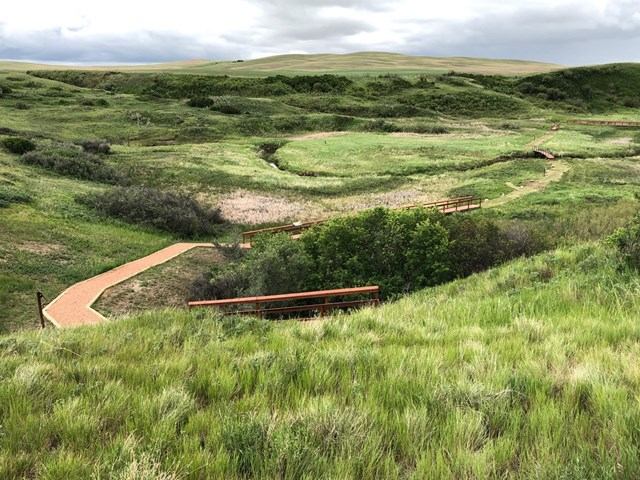The name "Michichi," used to describe a hamlet and surrounding area in east-central Alberta, Canada, within Starland County, has its roots in Indigenous language and culture. Specifically, the name derives from the Cree word ᒥᒋᐦᒋᕀ (micihciy), which translates to "hand." This name is a direct reference to the nearby Hand Hills, a geographical feature in the region, reflecting the cultural and environmental significance of the landscape to the Cree people who historically inhabited the area 36.
The hamlet of Michichi is located approximately 7 kilometers (4.3 miles) south of Highway 9 and about 121 kilometers (75 miles) northeast of Calgary. While the exact historical timeline of when the name was first applied to the area is not well-documented in available sources, it is clear that the name has Indigenous origins tied to the Cree language, predating European settlement in the region. The broader area of Starland County, where Michichi is situated, was traditionally home to the Blackfoot, who relied on bison herds for their livelihood, until the late 19th century when settlers arrived and the land was ceded to the Canadian government under Treaty 7 in 1877 58.
Michichi as a community likely emerged in the early 20th century, alongside other settlements in the region, following the establishment of the Canadian Pacific Railway in 1912, which spurred growth in nearby towns like Rowley and Craigmyle. Although specific records about the naming of the hamlet are scarce, the use of the Cree term suggests that early settlers or surveyors adopted an existing Indigenous name for the area, a common practice in Canadian place-naming during that era 58.
Today, Michichi remains a small hamlet with a population of 34 as of the 2013 municipal census conducted by Starland County. The name continues to reflect its Indigenous heritage, linking the modern community to the historical and cultural landscape of the Cree and other First Nations peoples who once thrived in the region 6.
Citations:
- https://www.learnalberta.ca/content/aswt/culture_and_language/documents/aboriginal_place_names.pdf
- http://metis.lti.cs.cmu.edu:8888/wikipedia_en_all_maxi_2022-05/A/Michichi
- https://en.wikipedia.org/wiki/List_of_place_names_in_Canada_of_Indigenous_origin
- https://digitalcollections.ucalgary.ca/archive/A-History-of-the-People-of-Michichi-2R3BF1FRRHWTU.html
- https://canadaehx.com/2022/05/09/the-history-of-starland-county/
- https://en.wikipedia.org/wiki/Michichi
- https://brethrenpedia.org/index.php/Alberta_history
- https://starlandcounty.com/vertical/sites/%7B27020476-4431-4EE6-9E32-5A73B290D9BC%7D/uploads/Starland_County_2022_Community_Profile.pdf
- https://forebears.io/surnames/michichi
- https://open.alberta.ca/dataset/e94f94c0-f573-4768-a79b-286bf9cfdc39/resource/06d6520d-35f8-4d81-ab77-afbf4ce4f0af/download/ab16_report.pdf
- https://rdrwa.ca/wp-content/uploads/2020/10/rdr_sowr_4_11_michichi.pdf
- https://scienceatlantic.ca/wp/site/wp-content/uploads/2015/10/AUGC-Conference-Program.pdf
- https://www1.agric.gov.ab.ca/$department/deptdocs.nsf/all/sag10989/$FILE/SNF_Gen_4_Report_01112017_Finalv2.pdf
Answer from Perplexity: pplx.ai/share


No comments:
Post a Comment